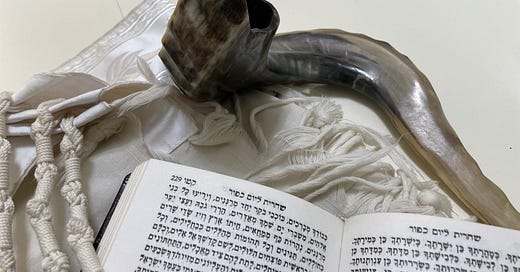The Thirteen Attributes of Mercy, According to Sefer Tomer Devorah
A printable PDF to put in your machzor
This post was originally published on September 23, 2023. I’m sharing it again now so that new subscribers can print out the PDF before Yom Kippur. Gmar chatima tova - may Hashem answer all our prayers for the good!
Rabbi Moshe Cordovero (1522-1570) was one of the greatest Kabbalists of all time. Known as the Ramak, he was the most prominent mystic in Safed before the arrival of the Arizal, and his written works, including the Pardes Rimonim, remain classics of Kabbalistic thought.
One of his books is Tomer Devorah, the introduction of which explains the meaning of each of the Thirteen Attributes of Mercy.
According to the Ramak’s system, the Thirteen Attributes appear twice in Tanach: first in Shemot 34:6-7, which we recite repeatedly throughout Selichot and on Yom Kippur, as well as in Micha 7:18-20. The two lists are not identical, but traditionally they are seen as parallel.
Why do we recite the Thirteen Attributes so many times during the weeks preceding Yom Kippur, as well as on Yom Kippur itself?
Chazal explain in the name of Rabbi Yochanan (Rosh Hashanah 17b) that God, so to speak, appeared like a prayer leader before Moshe, and told him that every time Israel sins, they should say the Thirteen Attributes of Mercy as a prayer, and God will forgive them.
I don’t think that Chazal believed that the Thirteen Attributes are a magic formula, where the mere recitation of the words guarantees forgiveness. Instead, I think that Chazal are telling us that by saying and thinking about these Attributes, we better understand the ways that God is merciful, so that we can act the same way ourselves. In other words, the point of our repeated recital of these verses is to internalize each of the Attributes of Mercy, so that we can forgive those who have wronged us just God forgives us.
And because, according to important currents in Jewish theology, God acts toward us in the way that we choose to act toward Him and others, our forgiving those who have done harm will be mirrored by God’s forgiving us.
In order to better facilitate our understanding of what each of the Attributes are, and how we can internalize them into our own lives, I composed the attached PDF that summarizes them according to the Ramak’s commentary. The relevant words in Shemot are followed by the parallel phrases in Micha in parentheses; this is then followed by an explanation of what each particular Attribute means, and the Ramak’s suggestion of ways that we can internalize each Attribute in our own lives.
I hope that this will help make our tefilot on Yom Kippur more meaningful, and will enhance our relationship with both God and humanity. I pray that the knowledge of God’s infinite love, expressed in part through His constant willingness to forgive, will inspire all of us to become the best people we can be, and to give everyone who needs it a second, third, and fourth chance to do better.
Gmar chatima tova!




Do we really need to ask for mercy? It might be thought that our wrong-doing needs punishment, but having already accepted a merciful G-d who is full of lovingkindness, we can surely feel that our situation will resolve itself on Yom Kippur, with our giving of charity, with prayer and penitence being sufficient.
Thanks!
Fyi, R Avraham Saba says this idea: צרור המור שמות ל"ד:ה'
והנה בכאן למדו סדר שלשה עשר מדות שבם מרחם ומכפר לחוטאים. וזאת היא תשובת שאלת הראני נא את כבודך. ולכן אמר ויעבור ה' על פניו. ללמדו היאך יסדר אלו הי"ג מדות. הוא והנמשכים אחריו לביטול הגזרות ולכפרת העונות. כאומרם ז"ל אלמלא מקרא כתיב אי אפשר לאומרו. כביכול נתעטף בטליתו ואמר לו כ"ז שישראל עושים כסדר הזה אינן חוזרות ריקם. שנא' הנה אנכי כורת ברית. ופירושו ידוע שהרי אנו רואים הרבה פעמים בעונותינו שאנו מעוטפים בטלית ואין אנו נענין. אבל הרצון כל זמן שישראל עושים כסדר הזה שאני עושה. לרחם לחנן דלים ולהאריך אפים ולעשות חסד אלו עם אלו. ולעבור על מדותיהן כאומרם כל המעביר על מדותיו וכו'. אז הם מובטחים שאינן חוזרות ריקם. אבל אם הם אכזרים ועושי רשעה. כל שכן שבהזכרת י"ג מדות הם נתפסין. . .
GCT